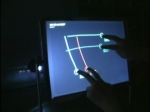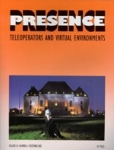Feb 13, 2006
Multisensory Interactive Installation
This article by Daniela Voto published on NOEMA describes a musical interactive system called "Multisensory Interactive Installation," (MII), which allows a user to paint and compose at the same time. But the most interesting feature of this installation is the implementation of artificial synesthesia (synesthesia is a neuropsychological phenomenon occurring when the stimulation of one sensory modality evokes a perception in one or more different senses).

Through MII, users can explore and manipulate visual elements, generating different musical outputs, constructing and deconstructing the art piece and/or creating a new work, and musical composition. The selection and organization of given visual-acoustic elements, determines the different musical atmosphere created by each user.
16:55 Posted in Cyberart | Permalink | Comments (0) | Tags: Positive Technology
Feb 11, 2006
Cloud

19:45 Posted in Emotional computing, Meditation & brain, Serious games | Permalink | Comments (0) | Tags: emotional computing, serious gaming
Feb 10, 2006
BCI-info
BCI-info is an open international platform for Brain-Computer Interface research. Hosted by BCI Lab, TU Graz, Austria, the platform aims to provide information for scientists, patients, students, the media, and people from the general public interested in BCI technology.

Registration and submissions are free., but contributions are reviewed by the BCI-info board.
20:56 Posted in Brain-computer interface | Permalink | Comments (0) | Tags: Positive Technology
Beyond reading thoughts
In an article recently appeared on the Observer, biologist Steven Rose argues the risk of a new era of mind control.
Concern about rising levels of mental distress have resulted in unprecedented levels of funding in the US and Europe. And a range of new technologies, from genetics to brain imaging, are offering extraordinary insights into the molecular and cellular processes underlying how we see, how we remember, why we become emotional.
Brain imaging has become familiar. Scanners, known by their initials - CAT, PET, MRI - began as clinical tools, enabling surgeons to identify potential tumours, the damage following a stroke or the diagnostic signs of incipient dementia. But neuroscientists quickly seized on their wider potential. The images of regions of the brain 'lighting up' when a person is thinking of their lover, imagining travelling from home to the shops, or solving a mathematical problem, have captured the imagination of researchers and public alike. What if they could do more?
Read full article
20:49 Posted in Research tools | Permalink | Comments (0) | Tags: Positive Technology
Feb 09, 2006
Train your brain with neurofeedback
The new edition of Scientific American Mind includes an interesting article on the use of neurofeedback to improve cognitive performance. I quote here an excerpt from the article
Such "mind reading" offers many possible applications. It has, for instance, enabled "locked-in" patients--who cannot speak or gesture--to communicate with caregivers [see "Thinking Out Loud," by Nicola Neumann and Niels Birbaumer; Scientific American Mind, Premier Issue, Vol. 14, No. 5, 2004]. By controlling their brain waves, the patients manipulate letters and words on a computer screen. Practice with neurofeedback may also benefit those who suffer from epilepsy, attention deficits, depression and other debilitating mental disorders. The experimental therapy, also called EEG biofeedback, may even help rev up healthy brains, improving cognitive performance.
16:59 Posted in Biofeedback & neurofeedback | Permalink | Comments (0) | Tags: Positive Technology
Feb 08, 2006
Dynamical Principles for Neuroscience and Intelligent Biomimetic Devices
March, 8-10, 2006, (Registration deadline: February 13 !) Ecole Polytechnique Fédérale de Lausanne (EPFL), Switzerland
Aim of the Conference
The goal of the conference is to bring together scientists and engineers interested in understanding the dynamical properties of the nervous system, and in taking inspiration from those properties for the design of prosthetic and robotic devices. The conference is interdisciplinary in nature, and aims at bringing together researchers working on similar topics and phenomena but from different backgrounds.
The conference is made possible thanks to the generous support of the Latsis Foundation. The presentations will consists of a series of invited talks (see below) and of poster presentations (with short poster spotlights).
For more background on the aim of the conference, please visit latsis2006.epfl.ch
Registration
------------
Registration for the EPFL-LATSIS Symposium 2006 is open. Please visit the website for information and registration form
15:26 Posted in AI & robotics | Permalink | Comments (0) | Tags: Positive Technology
Feb 07, 2006
Multi-Touch Interaction Research
via WMMNA
Jefferson Y. Han and coll. have developed multi-touch sensing technologies based on a technique called FTIR (frustrated total internal reflection), originally developed for fingerprint image acquisition. It acquires true touch information at high spatial and temporal resolutions, and is scalable to very large installations.
 Multi-touch sensing allows a user to interact with a system with more than one finger at a time, as in chording and bi-manual operations. Such sensing devices are also able to accommodate multiple users simultaneously, which is especially useful for larger interaction scenarios such as interactive walls and tabletops.
Multi-touch sensing allows a user to interact with a system with more than one finger at a time, as in chording and bi-manual operations. Such sensing devices are also able to accommodate multiple users simultaneously, which is especially useful for larger interaction scenarios such as interactive walls and tabletops.
See MPEG-1 demo and visit the project's web site
12:44 Posted in Future interfaces | Permalink | Comments (0) | Tags: Positive Technology
MobileHCI 2006
CALL FOR PAPERS
MOBILEHCI 2006
The 8th International Conference on Human-Computer Interaction with Mobile Devices and Services
Date: 12-15 September 2006
Location: Espoo, Finland
Website: www.mobilehci.org
Deadlines: *Papers, Workshops and Tutorials: 1 March 2006 *Short Papers, Posters, Demos, Panels, Industry Cases, Doctoral Consortium: 7 May 2006
Purpose
The 8th conference in the MOBILEHCI series provides a forum for academics and practitioners to discuss the challenges, potential solutions and innovations towards effective interaction with mobile systems and services. It covers the analysis, design, evaluation and application of human-computer interaction techniques and approaches for all mobile computing devices, software and services. Suggested topics include but are not limited to:
*Audio and speech interaction
*Context-dependent systems
*Designing Web sites for mobile devices
*Ethographical and field studies with mobile technology
*Evaluation of mobile devices and services
*Group interaction and mobility
*Intelligent environments
*Location-aware interaction
*Methods to evaluate mobile usability
*Model-based design of interactive mobile systems
*Mobile phenomena
*Mobility and work environments
*Multimodal interaction
*Novel user interfaces and interaction techniques
*Perception and modelling of the environment
*Safety issues (e.g., in-car user interfaces, payments)
*Specific classes of handheld devices (PDA, Pocket PC, WAP phone,...)
*3D graphics on mobile devices
*3G/4G devices and services
*Usability of mobile devices and services
*Visualization techniques for the mobile context
*Interdisciplinary perspectives towards mobile interaction (e.g. Social aspects)
*User centered design tools and methods for mobile systems
12:20 Posted in Call for papers | Permalink | Comments (0) | Tags: Positive Technology, mobile
Neurofeedback improves cognitive performance
Increasing individual upper alpha power by neurofeedback improves cognitive performance in human subjects.
Appl Psychophysiol Biofeedback. 2005 Mar;30(1):1-10
Authors: Hanslmayr S, Sauseng P, Doppelmayr M, Schabus M, Klimesch W
The hypothesis was tested of whether neurofeedback training (NFT)--applied in order to increase upper alpha but decrease theta power--is capable of increasing cognitive performance. A mental rotation task was performed before and after upper alpha and theta NFT. Only those subjects who were able to increase their upper alpha power (responders) performed better on mental rotations after NFT. Training success (extent of NFT-induced increase in upper alpha power) was positively correlated with the improvement in cognitive performance. Furthermore, the EEG of NFT responders showed a significant increase in reference upper alpha power (i.e. in a time interval preceding mental rotation). This is in line with studies showing that increased upper alpha power in a prestimulus (reference) interval is related to good cognitive performance.
11:55 Posted in Biofeedback & neurofeedback | Permalink | Comments (0) | Tags: Positive Technology, Biofeedback, neurofeedback
Can neurofeedback training enhance performance?
Can neurofeedback training enhance performance? An evaluation of the evidence with implications for future research.
Appl Psychophysiol Biofeedback. 2005 Dec;30(4):347-64
Authors: Vernon DJ
There have been many claims regarding the possibilities of performance enhancement training. The aim of such training is for an individual to complete a specific function or task with fewer errors and greater efficiency, resulting in a more positive outcome. The present review examined evidence from neurofeedback training studies to enhance performance in a particular area. Previous research has documented associations between specific cortical states and optimum levels of performance in a range of tasks. This information provides a plausible rationale for the use of neurofeedback to train individuals to enhance their performance. An examination of the literature revealed that neurofeedback training has been utilised to enhance performance from three main areas; sport, cognitive and artistic performance. The review examined evidence from neurofeedback training studies within each of these three areas. Some suggestive findings have been reported with regard to the use of neurofeedback training to enhance performance. However, due to a range of methodological limitations and a general failure to elicit unambiguous changes in baseline EEG activity, a clear association between neurofeedback training and enhanced performance has yet to be established. Throughout, the review highlights a number of recommendations to aid and stimulate future research.
11:53 Posted in Biofeedback & neurofeedback | Permalink | Comments (0) | Tags: Positive Technology
Feb 02, 2006
A meta-analysis of the training effectiveness of virtual reality surgical simulators
A meta-analysis of the training effectiveness of virtual reality surgical simulators.
IEEE Trans Inf Technol Biomed. 2006 Jan;10(1):51-8
Authors: Haque S, Srinivasan S
The increasing use of virtual reality (VR) simulators in surgical training makes it imperative that definitive studies be performed to assess their training effectiveness. Indeed, in this paper we report the meta-analysis of the efficacy of virtual reality simulators in: 1) the transference of skills from the simulator training environment to the operating room, and 2) their ability to discriminate between the experience levels of their users. The task completion time and the error score were the two study outcomes collated and analyzed in this meta-analysis. Sixteen studies were identified from a computer-based literature search (1996-2004). The meta-analysis of the random effects model (because of the heterogeneity of the data) revealed that training on virtual reality simulators did lessen the time taken to complete a given surgical task as well as clearly differentiate between the experienced and the novice trainees. Meta-analytic studies such as the one reported here would be very helpful in the planning and setting up of surgical training programs and for the establishment of reference 'learning curves' for a specific simulator and surgical task. If any such programs already exist, they can then indicate the improvements to be made in the simulator used, such as providing for more variety in their case scenarios based on the state and/or rate of learning of the trainee.
23:40 Posted in Cybertherapy | Permalink | Comments (0) | Tags: Positive Technology
Quantitative analysis of accuracy of an inertial/acoustic 6DOF tracking system in motion
Quantitative analysis of accuracy of an inertial/acoustic 6DOF tracking system in motion.
J Neurosci Methods. 2006 Jan 28;
Authors: Gilson SJ, Fitzgibbon AW, Glennerster A
An increasing number of neuroscience experiments are using virtual reality to provide a more immersive and less artificial experimental environment. This is particularly useful to navigation and three-dimensional scene perception experiments. Such experiments require accurate real-time tracking of the observer's head in order to render the virtual scene. Here, we present data on the accuracy of a commonly used six degrees of freedom tracker (Intersense IS900) when it is moved in ways typical of virtual reality applications. We compared the reported location of the tracker with its location computed by an optical tracking method. When the tracker was stationary, the root mean square error in spatial accuracy was 0.64mm. However, we found that errors increased over ten-fold (up to 17mm) when the tracker moved at speeds common in virtual reality applications. We demonstrate that the errors we report here are predominantly due to inaccuracies of the IS900 system rather than the optical tracking against which it was compared.
22:50 Posted in Research tools | Permalink | Comments (0) | Tags: Positive Technology
Effect of neurofeedback training on the neural substrates of selective attention
Effect of neurofeedback training on the neural substrates of selective attention in children with attention-deficit/hyperactivity disorder: A functional magnetic resonance imaging study.
Neurosci Lett. 2006 Feb 20;394(3):216-21
Authors: Lévesque J, Beauregard M, Mensour B
Attention Deficit Hyperactivity Disorder (AD/HD) is a neurodevelopmental disorder mainly characterized by impairments in cognitive functions. Functional neuroimaging studies carried out in individuals with AD/HD have shown abnormal functioning of the anterior cingulate cortex (ACC) during tasks involving selective attention. In other respects, there is mounting evidence that neurofeedback training (NFT) can significantly improve cognitive functioning in AD/HD children. In this context, the present functional magnetic resonance imaging (fMRI) study was conducted to measure the effect of NFT on the neural substrates of selective attention in children with AD/HD. Twenty AD/HD children-not taking any psychostimulant and without co-morbidity-participated to the study. Fifteen children were randomly assigned to the Experimental (EXP) group (NFT), whereas the other five children were assigned to the Control (CON) group (no NFT). Subjects from both groups were scanned 1 week before the beginning of the NFT (Time 1) and 1 week after the end of this training (Time 2), while they performed a Counting Stroop task. At Time 1, for both groups, the Counting Stroop task was associated with significant loci of activation in the left superior parietal lobule. No activation was noted in the ACC. At Time 2, for both groups, the Counting Stroop task was still associated with significant activation of the left superior parietal lobule. This time, however, for the EXP group only there was a significant activation of the right ACC. These results suggest that in AD/HD children, NFT has the capacity to normalize the functioning of the ACC, the key neural substrate of selective attention.
20:40 Posted in Biofeedback & neurofeedback | Permalink | Comments (0) | Tags: Positive Technology, Biofeedback, neurofeedback
Mu rhythm (de)synchronization and EEG single-trial classification of different motor imagery tasks
Mu rhythm (de)synchronization and EEG single-trial classification of different motor imagery tasks
Neuroimage. 2006 Jan 26;
Authors: Pfurtscheller G, Brunner C, Schlögl A, Lopes da Silva FH
We studied the reactivity of EEG rhythms (mu rhythms) in association with the imagination of right hand, left hand, foot, and tongue movement with 60 EEG electrodes in nine able-bodied subjects. During hand motor imagery, the hand mu rhythm blocked or desynchronized in all subjects, whereas an enhancement of the hand area mu rhythm was observed during foot or tongue motor imagery in the majority of the subjects. The frequency of the most reactive components was 11.7 Hz +/- 0.4 (mean +/- SD). While the desynchronized components were broad banded and centered at 10.9 Hz +/- 0.9, the synchronized components were narrow banded and displayed higher frequencies at 12.0 Hz +/- 1.0. The discrimination between the four motor imagery tasks based on classification of single EEG trials improved when, in addition to event-related desynchronization (ERD), event-related synchronization (ERS) patterns were induced in at least one or two tasks. This implies that such EEG phenomena may be utilized in a multi-class brain-computer interface (BCI) operated simply by motor imagery.
12:41 Posted in Brain-computer interface | Permalink | Comments (0) | Tags: Positive Technology
Working memory and acquisition of implicit knowledge by imagery training, without actual task performance
Working memory and acquisition of implicit knowledge by imagery training, without actual task performance
Neuroscience. 2006 Jan 27;
Authors: Helene AF, Xavier GF
This study investigated acquisition of a mirror-reading skill via imagery training, without the actual performance of a mirror-reading task. In experiment I, healthy volunteers simulated writing on an imaginary, transparent screen placed at eye level, which could be read by an experimenter facing the subject. Performance of this irrelevant motor task required the subject to imagine the letters inverted, as if seen in a mirror from their own point of view (imagery training). A second group performed the same imagery training interspersed with a complex, secondary spelling and counting task. A third, control, group simply wrote the words as they would normally appear from their own point of view. After training with 300 words, all subjects were tested in a mirror-reading task using 60 non-words, constructed according to acceptable letter combinations of the Portuguese language. Compared with control subjects, those exposed to imagery training, including those who switched between imagery and the complex task, exhibited shorter reading times in the mirror-reading task. Experiment II employed a 2x3 design, including two training conditions (imagery and actual mirror-reading) and three competing task conditions (a spelling and counting switching task, a visual working memory concurrent task, and no concurrent task). Training sessions were interspersed with mirror-reading testing sessions for non-words, allowing evaluation of the mirror-reading acquisition process during training. The subjects exposed to imagery training acquired the mirror-reading skill as quickly as those exposed to the actual mirror-reading task. Further, performance of concurrent tasks together with actual mirror-reading training severely disrupted mirror-reading skill acquisition; this interference effect was not seen in subjects exposed to imagery training and performance of the switching and the concurrent tasks. These results unequivocally show that acquisition of implicit skills by top-down imagery training is at least as efficient as bottom-up acquisition.
12:40 Posted in Mental practice & mental simulation | Permalink | Comments (0) | Tags: Positive Technology
Intelligent inferencing and haptic simulation for Chinese acupuncture learning and training
Intelligent inferencing and haptic simulation for Chinese acupuncture learning and training.
IEEE Trans Inf Technol Biomed. 2006 Jan;10(1):28-41
Authors: Heng PA, Wong TT, Yang R, Chui YP, Xie YM, Leung KS, Leung PC
This paper presents an intelligent virtual environment for Chinese acupuncture learning and training using state-of-the-art virtual reality technology. It is the first step toward developing a comprehensive virtual human model for studying Chinese medicine. Students can learn and practice acupuncture in the proposed 3-D interactive virtual environment that supports a force feedback interface for needle insertion. Thus, students not only "see" but also "touch" the virtual patient. With high performance computers, highly informative and flexible visualization of acupuncture points of various related meridian and collateral can be highlighted to guide the students during training. A computer-based expert system using our newly proposed intelligent fuzzy petri net is designed and implemented to train the students to treat different diseases using acupuncture. Such an intelligent virtual reality system can provide an interesting and effective learning environment for Chinese acupuncture.
12:40 Posted in Virtual worlds | Permalink | Comments (0) | Tags: virtual reality, cybertherapy
Control over brain activation and pain learned by using real-time functional MRI
Control over brain activation and pain learned by using real-time functional MRI.
Proc Natl Acad Sci USA. 2005 Dec 20;102(51):18626-31
Authors: deCharms RC, Maeda F, Glover GH, Ludlow D, Pauly JM, Soneji D, Gabrieli JD, Mackey SC
If an individual can learn to directly control activation of localized regions within the brain, this approach might provide control over the neurophysiological mechanisms that mediate behavior and cognition and could potentially provide a different route for treating disease. Control over the endogenous pain modulatory system is a particularly important target because it could enable a unique mechanism for clinical control over pain. Here, we found that by using real-time functional MRI (rtfMRI) to guide training, subjects were able to learn to control activation in the rostral anterior cingulate cortex (rACC), a region putatively involved in pain perception and regulation. When subjects deliberately induced increases or decreases in rACC fMRI activation, there was a corresponding change in the perception of pain caused by an applied noxious thermal stimulus. Control experiments demonstrated that this effect was not observed after similar training conducted without rtfMRI information, or using rtfMRI information derived from a different brain region, or sham rtfMRI information derived previously from a different subject. Chronic pain patients were also trained to control activation in rACC and reported decreases in the ongoing level of chronic pain after training. These findings show that individuals can gain voluntary control over activation in a specific brain region given appropriate training, that voluntary control over activation in rACC leads to control over pain perception, and that these effects were powerful enough to impact severe, chronic clinical pain.
12:38 Posted in Biofeedback & neurofeedback | Permalink | Comments (0) | Tags: Positive Technology
New Scientist: special on robotic
The journal New Scientist proposes a special report focusing on robots that have the ability to mimic or model specific aspects of human behavior.

12:35 Posted in AI & robotics | Permalink | Comments (0) | Tags: Positive Technology
Jan 30, 2006
Presence 14:6 Now Available
Special Section:
Legal, Ethical, and Policy Issues Associated with Virtual Environments and Computer Mediated Reality

Articles
Sousveillance and Cyborglogs: A 30-Year Empirical Voyage through Ethical, Legal, and Policy Issues
Steve Mann
Buddy Bots: How Turing's Fast Friends are Undermining Consumer Privacy
Ian R. Kerr and Marcus Bornfreund
The Philosophy of Presence: From Epistemic Failure to Successful Observation
Luciano Floridi
Some Practical Considerations of Ethical Issues in VR Research
Katharina-Maria Behr, Andreas Nosper, Christoph Klimmt and Tilo Hartmann
Evaluation of a Haptic Mixed Reality System for Interactions with a Virtual Control Panel
Christoph W. Borst and Richard A. Volz
Leaving the World Behind: Supporting Group Collaboration Patterns in a Shared Virtual Environment for Product
Design John M. Linebarger, Christopher D. Janneck and G. Drew Kessler
Feedback Strategies for Telemanipulation with Shared Control of Object Handling Forces
Weston B. Griffin, William R. Provancher and Mark R. Cutkosky
Virtual Environment Training Therapy for Arm Motor Rehabilitation
Lamberto Piron, Paolo Tonin, Francesco Piccione, Vincenzo Iaia, Elena Trivello and Mauro Dam
Forum Issues of Law for Software Agents Within Virtual Environments
Woodrow Barfield
21:10 Posted in Telepresence & virtual presence | Permalink | Comments (0) | Tags: Positive Technology, Presence
Jan 28, 2006
Telepresence and Bio Art
Via Boing-Boing
For nearly two decades Eduardo Kac has been at the cutting edge of media art, first inventing early online artworks for the web and continuously developing new art forms that involve telecommunications and robotics as a new platform for art. Interest in telepresence, also known as telerobotics, exploded in the 1990s, and remains an important development in media art. Since that time, Kac has increasingly moved into the fields of biology and biotechnology.
 Telepresence and Bio Art is the first book to document the evolution of bio art and the aesthetic development of Kac, the creator of the "artist's gene" as well as the controversial glow-in-the-dark, genetically engineered rabbit Alba. Kac covers a broad range of topics within media art, including telecommunications media, interactive systems and the Internet, telematics and robotics, and the contact between electronic art and biotechnology. Addressing emerging and complex topics, this book will be essential reading for anyone interested in contemporary art. Artist Eduardo Kac is internationally recognized for his interactive Internet installations and his bio art. A pioneer of telecommunications art in the pre-web '80s, Kac emerged in the early '90s with his radical telepresence and biotelematic works.
Telepresence and Bio Art is the first book to document the evolution of bio art and the aesthetic development of Kac, the creator of the "artist's gene" as well as the controversial glow-in-the-dark, genetically engineered rabbit Alba. Kac covers a broad range of topics within media art, including telecommunications media, interactive systems and the Internet, telematics and robotics, and the contact between electronic art and biotechnology. Addressing emerging and complex topics, this book will be essential reading for anyone interested in contemporary art. Artist Eduardo Kac is internationally recognized for his interactive Internet installations and his bio art. A pioneer of telecommunications art in the pre-web '80s, Kac emerged in the early '90s with his radical telepresence and biotelematic works.
19:40 Posted in Cyberart | Permalink | Comments (0) | Tags: Positive Technology, cyberart






